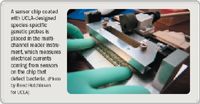Article
New test finds UTI cause in 45 minutes; 98% accurate
Los Angeles--A new biosensor technology that can identify the bacterial cause of urinary tract infections with 98% accuracy within 1 hour may help both clinicians and patients by closing the gap between diagnosis and appropriate treatment.

In a clinical study conducted by the David Geffen School of Medicine at UCLA and the Veterans Affairs Greater Los Angeles Healthcare System, researchers used a microfabricated electrochemical sensor array developed by Gene Fluidics (Monterey Park, CA) to identify the bacterial species implicated in urinary tract infections in 78 clinical specimens.
"This study is the first ever species-specific detection of bacteria in human clinical fluid samples using a microfabricated electrochemical sensor array," said Bernard Churchill, MD, chief of pediatric urology at the Clark-Morrison Children's Urological Center at UCLA, primary investigator in the study.
The 16 sensors in the array each contained single-layer gold electrodes dedicated as working, reference, and auxiliary. Each electrode contained one representative, specific to a clinically relevant bacterial urinary pathogen, from a library of capture probes. Among the pathogens were Escherichia coli, Proteus mirabilis, Pseudomonas aeruginosa, Entercococcus spp, and the Klebsiella-Enterobacter group, although the universe of pathogens is limited only by the availability of reference pathogens.
A bacterial 16s rRNA target derived from a single-step bacterial lysis was hybridized both to the biotin-modified capture probe and to an enzymatic reporter molecule, a horseradish peroxidase (HRP)-conjugated anti-fluorescein modified antibody, which is affixed to the detector probe. By passing an electrical signal between the two probes and observing which electrodes display a signal during the HRP reaction, researchers were able to identify the specific pathogen present in the sample.
Within 45 minutes from the start of the study, the device identified the specific species of gram-negative bacteria with 98% accuracy from culture, inoculated urine, and clinical urine samples containing as few as 2,600 uropathogenic bacteria. Further, in a feasibility study of the device using blinded clinical urine specimens, the sensor array demonstrated 100% specificity for direct detection of the bacteria without need for repeated copying of DNA or RNA prior to testing.
In a clinical setting, this means the current 2-day delay between specimen collection, culturing, and analysis and treatment of the infection could be compressed to just 45 minutes, and targeted antibiotic treatment would eliminate the current interim hit-or-miss drug therapy.
In the hospital setting, the pathogenic dangers to catheterized patients could be more efficiently managed, and laboratory backlog reduced. For patients, discomfort, inconvenience, and expense would be minimized.
Describing the results as "impressive," Dr. Churchill suggested the speed and accuracy of this new biosensor technology would "enable physicians to make dramatically superior clinical decisions."
Research continues at UCLA and the VA Medical Center to improve detection methods that can make the technology more accessible to the clinical realm. And research is sorely needed: Urinary tract infections are the most common bacterial infection in the United States. More than 1 million hospitalizations and 7 million office visits each year are due to urinary tract infections, and the cost to the U.S. health care system in 2000 was $3.5 million.





